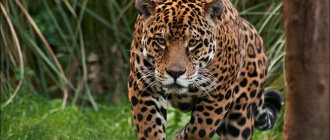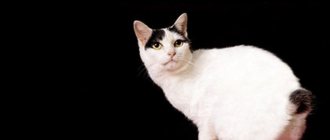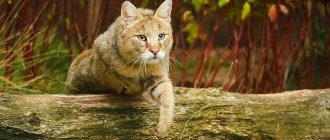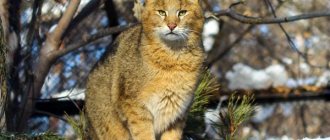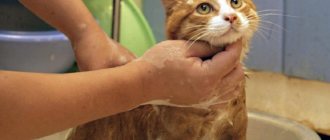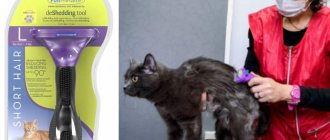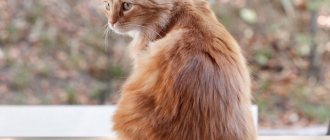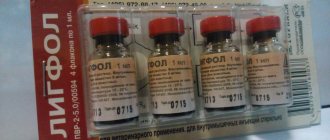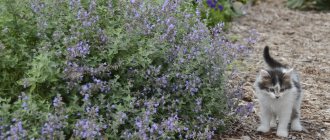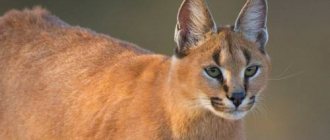Despite the fact that cats are usually associated with cute and kind creatures, among them there are 10 of the most dangerous breeds in the world. Felines are predators by nature, but the representatives listed below, even after many years of domestication, can behave aggressively and exhibit traits characteristic of their wild relatives. Before getting yourself a pet, it is advisable to know the characteristics of the chosen breed. After all, an aggressive character can cause many problems, from damaged things to scratched arms and legs. The latter is especially true for families with small children, because not all animals are ready to tolerate constant “manifestations of love” on their part. But it should be borne in mind that outbursts of aggression can be associated with stress, illness, threat, and then belonging to a certain breed will not matter at all.
Siberian breed
Fluffy large cats often agree to be friends only with their owner and bravely protect their possessions from the encroachments of strangers, so their character is often compared to that of a dog. They will not become aggressive without a good reason. If one appears, they will fight to the last, because it’s not for nothing that they are on the list of dangerous cats. Siberians are very loyal and need companionship, but obsessive attention can also cause aggressive behavior.
Don Sphynx
Common people often confuse this breed with the Canadian Sphynx breed. They are similar, which is why both were included in our rating. The completely naked body is covered with wrinkled skin, because of this the expression of the muzzle looks like an old man. The bald, thin tail, curving like a wave, resembles a rat's. A smooth belly is compared to a pork belly. He's still a "freak"!
Yes, an ugly cat looks scary, but this is a deceptive impression. Don Sphynxes are friendly, inquisitive, intelligent pets. The animals get along well with people and other pets.
What is the price
In Russian nurseries - 15,000 - 40,000 rubles; in Ukraine – 3,500 – 30,000 UAH.
Author's comment
Want a pet that looks like an otherworldly creature? The Don Sphynx will make your dream come true.
The most evil cats in the world
Cats are one of those animals that are associated with the affectionate furry creatures of nature. But among them there are also those that are distinguished by their wayward and sometimes quite aggressive character. Who are these clawed predators? We bring to your attention the top 10 most evil cat breeds.
Any cats, whether wild or purebred domestic cats, belong to the order of predators. In representatives of some breeds, the hunting instinct is preserved only at the rudimentary level of a rudiment, while in others it manifests itself quite clearly. Who tops the ranking of the most evil cats in the world?
Siamese
Representatives of the Siamese breed attract people with their exceptional memory and intelligence. They not only remember the insult caused, but are also ready to take revenge for it. Siamese are intelligent and easy to train. But the requirements set by the owner cannot subsequently be changed. This will lead to misunderstanding and resentment of the animal.
One of the reasons why Siamese cats exhibit an angry temperament is their fierce loyalty to their owner. If an animal feels that it or its “ward” is in danger, it is ready to use its teeth and claws.
Maine Coons
They are very confident and good-natured animals. The very understanding that they are larger than other representatives of the cat tribe has formed in them a phlegmatic attitude towards the world.
But among Maine Coons there are also comrades who are ready to demonstrate indignation at the sight of strangers in the form of a hiss and an animal grin. These are rather flaws in upbringing. When you decide to have these smart cats at home, you should follow the rule: the animal’s character needs to be nurtured and its temperament trained.
Jungle cats
Representatives of this breed can only be called domesticated. Jungle cats are rightfully among the most evil breeds, because they especially clearly represent the natural inclinations of predators.
Experimenting with such exotic things is definitely not worth it in families with small children. The complexity of the educational process can be compared to an attempt to tame a wild lynx or cheetah cub.
Scottish
There is an opinion that Scottish cats lack aggression at the genetic level. Yes, for the most part they are independent and do not like hands. But still among them there are individuals that are striking in their tough temperament and intolerance to excessive attention.
There may be several reasons why Scottish cats show anger and even aggressiveness. This is a special attitude towards one’s own space, which manifests itself in not allowing one to do whatever a person wants with oneself, and an expression of dissatisfaction due to the pain experienced. Cats can also show a tendency to become angry during hormonal changes. Therefore, the owner’s task is to pay enough attention to the pet, but not to be intrusive.
The short-haired beauties, which became the property of the British Empire, “captivate” with their independent disposition and imperturbable calm that remains in any situation. Although they become attached to their owners, they are not ready to tolerate excessive familiarity.
The most common reason why British cats show anger and aggression is stress during forced contact with a person and pain in the animal, which it may experience due to chronic diseases.
Savannah
Spotted, graceful beauties, resembling a smaller copy of African sevrals, are famous for their intelligence and curiosity. These domesticated predators are ready to hunt every second.
They become very attached to their owners. But towards strangers they often demonstrate aggression and a wild disposition. This behavior is explained by the fact that in moments of danger, the blood of their wild ancestors “wakes up” in the savannas.
Pallas' cat
By their nature, Pallas' cats are real wild animals. It is not without reason that they are considered one of the most evil cat breeds. After all, they are secretive and independent, and in case of danger they like to lie in wait.
Even after living next to humans for many years, Pallas' cats are capable of demonstrating their predatory habits at any moment. Sensing danger, the cat can pounce on the enemy, piercing him with its long claws and terrifying fangs. And the fangs of Pallas’ cats are three times longer than those of representatives of other breeds.
Representatives of the Chausie breed are considered among the most evil cat breeds for the reason that jungle cats took part in their selection. The ancestors certainly never had an easy-going character. Therefore, “wild” blood still continues to influence the character of the chausie.
Yes, they are sociable and gentle. But with improper upbringing, they can do things unthinkable for pets.
Mekong Bobtails
When you look at these cute creatures with “bunny” tails, it’s hard to believe that they could pose a danger. But close kinship with the Siamese played a role.
Bobtails are famous for their independence, willfulness and distrust. Miniature predators, similar in character to watchdogs, are able to easily repel strangers. If necessary, they do not hesitate to use their tenacious claws and sharp curved fangs. No wonder animal lovers consider them ideal home guards.
Bengal
Bengal cats are famous for their high intelligence and reserved manners. But this does not prevent them from showing their wild nature from time to time and clearly demonstrating a pronounced hunting instinct. The reason lies in the fact that representatives of this breed were bred by hybridization by crossing domestic pets with wild animals.
Bengalis are by nature difficult to educate. They do not like to obey family routines. They are jealous of the boundaries of personal space. You can establish contact with them only through friendliness.
Useful materials:
- The cat has cancer Stages of mammary gland cancer in cats Like in humans, cat mammary cancer has ...
- Cutaneous horn General description of the disease Cutaneous horn on the forehead or face (ICD 10 code - L57.0) -...
- Cat's eye Causes and signs of various types of eye diseases in cats Cats have many eye diseases. Necessary…
- Itching and odorless discharge Main causesBefore considering the factors that provoke the appearance of discharge that has a sour odor, it is necessary to immediately note...
Likoy
Another breed of scary cats is the Lykoi. You won't find any handsome guys among the representatives of this family! The cats live up to the name. Werewolf - this is how the name of this breed is translated. Pets look terrifying and shocking at first sight. The exterior of the Lykoi resembles an explosive mixture of a wolf, a bat and a yard cat. Black and gray fur of varying lengths looks sloppy due to bald spots all over the cat's body.
Despite its ugly appearance, the breed is expensive and popular. Lykoi are loyal pets that can defend their owner just as well as dogs. Cats are friendly, love to be the center of attention, and are easy to care for.
What is the price
In Russia – 30,000 – 80,000 rubles; in Ukraine – 26,000 – 60,000 UAH.
Author's comment
If you want people to ask: “What is your cat’s illness?”, get a Lykoya kitten. You will be able to proudly answer: “My cat is not sick, this is a new fashionable breed!”
Peterbald
Another representative of the cat family, which can hardly be called “handsome”. Rather, he looks scary. Pointed ears, a long narrow head, huge almond-shaped eyes, webbed feet, an angular, wrinkled, hairless body - this is a description of the Petersburg Sphynx breed, which is also called the Peterbald.
The world is full of fans of cats with an exterior of controversial beauty. Owners adore cats for their affection for people. Peterbalds are active, very smart, inquisitive cats. They are loving and peaceful. Get along with all family members and other pets.
What is the price
In Russian nurseries, naked folded kittens are offered for 18,000 - 60,000 rubles; in Ukraine – 6,000 – 16,000 UAH.
Author's comment
Original cats, with their webbed paws, easily turn door handles and can hold objects in their paws like human beings.
Chausie
The chausie is also not of the kindest disposition; it is wild and capricious, slightly reminiscent of a puma in appearance. The chausie is distinguished by its size and highly developed hunting instinct. There is no place for them in a small apartment because of their large dimensions and desire to run around, their love of occupying mezzanine and above closet spaces, creating reserves and secret storage areas, which the owners will periodically access.
Manul
What distinguishes the Pallas cat from other cats is that it cannot be domesticated. Despite the fact that he is the size of most cats, his character is not like everyone else. Even if you take it from birth, it still will not take root, because in the wild it bypasses even its fellows.
The length of the Pallas' cat reaches 65 cm, and the weight is 5 kg. At first it may seem that it is very large and heavy, but this impression is created due to the fact that the cat has thick and fluffy fur. Those who decide to have such a pet need to know the following:
- he will always hide from his owners, because he is a wild cat;
- the manul will spoil furniture, things, wallpaper in the apartment, and it will not be possible to wean him off;
- Shedding of the Pallas's cat will also be a big problem due to its thick fur, since it will have to be combed every day, and the wool will be all over the apartment;
- curing a pet even in a veterinary clinic will be problematic, because it will be treated like an ordinary cat, while the Pallas's cat gets sick easily and has difficulty withstanding infections.
Is it possible to retrain them as aggressive cats?
Man domesticated the cat 10,000 years ago. He wanted a true friend. But despite such a long period of cohabitation, people have achieved little in this matter. Cats remain independent creatures. They love the comfort of home and owners, but can easily run away in search of adventure when nature calls.
Hybrids of domestic cats and wild relatives cannot be completely tamed. After all, wild blood in a fight with the best genes of purebred cats will ultimately win. Independence is often higher than loyalty for cats.
Independence is in the blood of cats
Mekong Bobtail
The Mekong Bobtail is the safest cat breed compared to all of the above. The height of a cat of this species reaches 30 centimeters at the withers, and it weighs no more than 4 kilograms.
If you train such a pet, it will be docile and calm. However, the Mekong Bobtail only gets used to one person. As a rule, he listens only to his master. The pet is wary of strangers. If he doesn't like something, he can easily attack a stranger.
The main danger of these 5 breeds is that they all come from wild cats. Consequently, raising such pets is extremely difficult. Only those who are willing to train and care for them should own such pets.
Munchkin
Of course, it was impossible not to include in the rating the progenitor of the Minskin and Bambino breeds. It is difficult to call a Munchkin a scary cat; this breed is more suited to the definition of an unusual, strange cat. These are absolutely cute pets with a familiar feline appearance. If it weren't for their short legs, they would be no different from ordinary domestic cats.
Cats of this breed, whose development is based on a genetic defect, have a controversial attitude in the world. Not all felinologists believe that it is permissible to breed deformed cats on purpose. Nevertheless, half-cats have enough fans. Munchkins are affectionate and playful pets by nature.
Price
In Russia – 20,000 – 70,000 rubles; in Ukraine – 10,000 – 40,000 UAH.
Author's comment
If you want a dachshund, but can’t decide who you like more: cats or dogs, get a munchkin.
Bengal cats
Bengal cat
This breed of domestic cat is distinguished by its impulsive character and clearly expressed hunting instinct. Thanks to their muscular body, Bengals easily adapt to different living conditions. From birth, a kitten needs education, care and affection so that it does not grow into an aggressive monster. You need to spend a lot of time on a Bengal because they are very active. This breed does not like to sit in the arms of its owner and does not tolerate shouting at itself or raising its voice. If a cat gets angry, it will immediately begin to attack its owner. An angry Bengal cat can seriously harm a person, and history knows many such cases of attacks on their owners by Bengals. Bengal cats remain active until old age, so they are not averse to playing even when they are old. Therefore, they attack everything that moves within their reach. Not all owners are happy with this behavior. Owners of Bengal cats must be patient.
Aggressive cat breeds: features, how to influence
Some domestic cats have a naturally explosive temperament; before choosing a specific breed, you need to familiarize yourself with its character and understand whether it matches the conditions in which the future pet will live.
Be sure to read:
Translator from cat to Russian: what is it, 13 basic gestures of a cat’s body, how to recognize sounds
If there are children in the family who will be allowed to constantly cuddle and stroke an animal that has a love of independence, personal space, you should not scold it later for scratches and bites left on the hands of a son and daughter.
Persian cat
The look and expression of the Persian's muzzle evokes thoughts of a complex, unvarnished character. The breed standard states that purebred specimens must be calm, balanced, and not show active aggression towards people and animals.
Cats are pride creatures; they are not leaders in a pack of people, but they do not assign themselves the place of “omega.” They choose the main owner, and the rest are condescendingly tolerated. It is not possible to influence the choice; the Persian will decide for himself who to give his love, purring, warmth.
The fluffy handsome man cannot live without human company; from long loneliness he begins to get sick and becomes sad. They get along well with children, as long as they do not turn the animal into a toy.
A Persian can show aggression in an extreme situation, defending himself from pain, intrusive attention that goes beyond the boundaries of common sense, and experiencing fear.
Ocicat
The breed received official registration in 1987 and is a derivative of a mixture of Siamese, Abyssinian and American Shorthair blood. The appearance of Ocicats is colorful, reminiscent of wild cats. Personality: sociable, inquisitive, friendly.
Pets are “talkative” and express the entire range of emotions with their voices. Not receiving enough attention to the person, they begin to sing, meow, influencing the owner in every way, reminding them of themselves. They have a tenacious memory, a remarkable mind, and quickly figure out how to open a refrigerator or closet door. They are easy to teach funny tricks. They are playful, active, aggression is not a characteristic feeling for them.
Turkish Angora
The most delicate snow-white cloud with huge eyes - this is how you can describe these stunningly beautiful cats. Their fur is silky, delicate, flowing between the fingers like silk, does not require special care, and is not prone to tangles.
At the end of the last century, individuals were selected for breeding solely on the basis of external characteristics, paying little attention to character. Often at exhibitions, Angora cats hissed at strangers and could scratch or bite an expert who picked them up.
Hence the assertion that the breed belongs to the aggressive ones was born. Over time, breeders paid more attention to issues of character when mating, and today beautiful cats of purebred lines have a pleasant sociable nature, love affection, and are willing to make contact with humans.
Ukrainian Levkoy
The only breed bred in Ukraine, it was formed from the love of the Don Sphynxes and the British Fold. The exotic combination of a naked body and small pendulous ears captivated visitors to the exhibition, where the Levkoy was first shown in 2005.
Be sure to read:
Do cats understand people: how they recognize through intonation, gestures and smell, cat telepathy.
They got their name because of the similarity of the structure of their ears with the flower of the same name.
Hairless Ukrainian cats, despite their spectacular appearance, are simple in their maintenance and not whimsical. They have an extreme degree of curiosity and will not miss a single, even the most insignificant event in the house.
They have a balanced temperament, get along well with children and other pets, and show interest in guests.
The main gentleman is loved to the point of unconsciousness, following on his heels; the rest of the family members are also not deprived of attention and affection. Levkoys are not at all vindictive; aggression can manifest itself in extreme situations or in the kitten’s puberty, but usually does not go beyond limits.
Siamese cat
The statement about the viciousness of the Siamese is partly true. The character of these cats is picky and complex. An animal can completely love its owner, but also become disappointed in him when faced with rudeness or the use of physical or moral violence.
In this case, a small but proud animal will really take revenge with all the cat’s strength, shitting in slippers, spoiling objects, and attacking openly.
Siamese have a hard time with loneliness, succumb to attacks of jealousy, are distrustful of strangers, and if a guest tries to get too close and too intense, they can resist.
Abyssinians
Abyssinian cat
Cats of the Abyssinian breed are very vindictive and angry. They have dense, thick fur of a tricolor color. Abyssinian cats do not like to sit on their owner’s lap for a long time, preferring a higher place where they would be out of reach. Because of their rancor, it takes a lot of time to raise them. You need to be prepared for the bites and scratches that usually end up playing with them. Breeders note that Abyssinians easily get along not only with people, but also with other animals. But if something is not to their liking, aggression will not be long in coming. These are very inquisitive and attentive animals, moderately mobile and capable of occupying themselves independently in the absence of their owners. Their games often cause scratches on furniture and ties on curtains that they don’t mind hanging on. But it’s better not to scold them for this, otherwise you may encounter aggression. If an Abyssinian wants to rest, he will climb onto his owner’s lap. This breed is quite silent and rarely bothers with its screams. The owner, if desired, can start training his Abyssinian dog: teach her to fetch something or walk on a leash. Developed intelligence and devotion are the strengths of the Abyssinians; they follow their owner everywhere because they do not tolerate loneliness.
Savannah
This breed is not only one of the most dangerous, but also the most expensive in the world. These are graceful, intelligent and active cats that can easily learn to walk on a leash. They are prone to savagery and aggression, and may even perceive strangers as objects of hunting, which should be taken into account during walks or when leaving them alone with a stranger. This is not surprising, because Savannah cats are direct descendants of the wild African serval. The first generation cubs can be especially dangerous for people.
